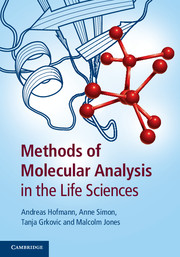2 - Spectroscopic methods
Published online by Cambridge University Press: 05 July 2014
Summary
Atomic spectroscopy
Electronic transitions in single atoms yield clearly defined line spectra. In atomic emission spectroscopy (AES), these lines can be observed as light of a particular wavelength (colour). Conversely, black lines can be observed against a bright background in atomic absorption spectroscopy (AAS). The wavelengths emitted from excited atoms may be identified using a spectroscope with the human eye as the ‘detector’, or with a spectrophotometer. Both methods are used mainly for the analysis of metals, as well as some metalloids (such as boron, silicon, germanium, arsenic, antimony and tellurium) and a few non-metals (phosphorus).
Using light of high energy (e.g. X-rays), fluorescence from an electronic transition within individual atoms can be elicited.
Principles
In a spectrum of an element, the absorption or emission wavelengths are associated with transitions that require a minimum of energy change. In order for energy changes to be minimal, transitions tend to occur between orbitals close together in energy terms. For example, excitation of a sodium atom and its subsequent relaxation gives rise to emission of orange light (‘D-line’) due to the transition of an electron between the 3s and 3p orbitals (Fig. 2.1).
Electron transitions in an atom are limited by the availability of empty orbitals. Filling orbitals with electrons is subject to three major rules:
Any one orbital can be occupied by a maximum of two electrons.
The spins of electrons in one orbital need to be paired in an anti-parallel fashion (Pauli principle).
Energetically equivalent orbitals are first to be filled with electrons of parallel spin; only then can a second electron with anti-parallel spin be added (Hund’s rule).
- Type
- Chapter
- Information
- Methods of Molecular Analysis in the Life Sciences , pp. 10 - 94Publisher: Cambridge University PressPrint publication year: 2014



